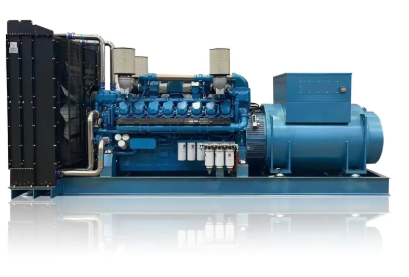Understanding the Basics of a 30kVA Generator
What Does kVA Mean?
kVA, or kilovolt-amperes, is a crucial unit in electrical systems, measuring apparent power. It signifies the product of voltage and current in a system, essentially the total power capacity available. Where watts measure actual power output, kVA indicates the potential power a system can handle. This distinction is essential because electrical systems rarely achieve perfect efficiency; thus, apparent power (kVA) often exceeds the actual usable power (kW), providing a broader view of an electrical circuit's capacity.
kVA vs. kW: Key Differences
Understanding the relationship between kVA and kW is essential for correctly assessing generator capacity. The primary formula connecting these units involves the power factor: kW = kVA x Power Factor. Here, the power factor represents the efficiency of an electrical system, usually between 0 and 1. For instance, a generator with a power factor of 0.8 will convert 100 kVA into 80 kW of usable power. Scenarios where kVA is more relevant include specifying generator capacity, while kW is often used for actual energy consumption measurements.
Power Factor and Its Role in Generator Efficiency
Power factor, mathematically expressed as the ratio of kW to kVA, significantly impacts generator efficiency. A low power factor indicates that the generator is not utilizing its full potential, leading to wasted energy and higher operational costs. Generators typically exhibit an average power factor of 0.8 under various loading conditions, meaning only 80% of the apparent power is converted into useful work. Improving power factor can enhance efficiency, reduce costs, and improve system performance by minimizing energy losses.
Core Components of a 30kVA Generator
Diesel Engine: The Power Source
Diesel engines are renowned for their efficiency and reliability, making them the preferred choice for 30kVA generators. These engines are designed to provide power consistently, handling the electrical demand with precision. Diesel engines typically operate at a range of RPMs that ensures optimal energy conversion while maintaining fuel efficiency. Their performance often surpasses other engine types due to the higher energy density of diesel fuel. For instance, compared to gasoline engines, diesel engines exhibit superior fuel efficiency and longevity, which are crucial for uninterrupted power supply in critical applications.
Alternator and Electromagnetic Induction
An alternator is a fundamental component responsible for converting mechanical energy into electrical energy through electromagnetic induction. It comprises various parts, including the rotor and stator, which work in tandem to generate a consistent power output. As the rotor spins, it creates a magnetic field that induces electricity in the stator, supplying power to the connected load. The design of the alternator significantly influences the generator's performance; for example, high-quality materials and precise engineering can enhance durability and efficiency. By optimizing these components, manufacturers can ensure that their 30kVA generators offer reliable and efficient power generation.
Voltage Regulator and Stability
The voltage regulator plays a pivotal role in maintaining stable output voltage from a generator. By adjusting the excitation of the alternator, the voltage regulator ensures that fluctuations in power supply do not affect the integrity of the electricity produced. Various types of regulators, such as electromechanical and electronic, cater specifically to generators, emphasizing reliability and precision. Stability issues can severely impact generational efficiency and reliability; therefore, a robust voltage regulator is vital to ensure seamless operation. Without such regulation, a generator might experience voltage spikes, leading to potential equipment damage and decreased efficiency.
Fuel, Cooling, and Exhaust Systems
Fuel systems in generators are intricately designed to deliver the required energy for smooth operation. Efficiently functioning fuel systems are essential for sustaining long-term generator performance and minimizing operational costs. Similarly, cooling systems are critical in preventing overheating, thereby prolonging the generator’s lifespan. Effective cooling ensures that the engine operates within safe temperature ranges, avoiding potential damage. Exhaust systems manage emissions and direct them safely away from the operational area, adhering to environmental standards. These systems collectively contribute to reliable and eco-friendly generator operation, ensuring optimal power delivery while safeguarding the environment.
How a 30kVA Generator Works
Mechanical to Electrical Energy Conversion
The process of converting mechanical energy to electrical energy in a 30kVA generator is fundamental to its operation. Initially, the diesel engine combusts fuel, producing mechanical energy through the rotational movement of the crankshaft. This rotation is pivotal, as it powers the generator's rotor, converting mechanical energy into electrical energy via electromagnetic induction. Thermodynamic principles play a crucial role in this conversion, ensuring efficiency and effectiveness. In practical applications, such as backup power systems, a 30kVA generator reliably transforms stored chemical energy from diesel into usable electricity, underscoring its importance in contemporary power solutions.
Role of the Rotor and Stator in Power Generation
In a 30kVA generator, the rotor and stator are essential components driving power generation. The rotor, attached to the crankshaft, spins within the stator's magnetic field, creating an alternating current through electromagnetic induction. This interaction between the rotor and stator is crucial as it represents the heart of electricity generation. The rotor speed significantly influences the generator's output, typically set to match the demand for consistent energy supply. A well-coordinated rotor and stator setup ensures efficient electricity production, making these components vital in sustaining reliable power generation.
Three-Phase Power Output Explained
A crucial feature of many 30kVA generators is their ability to deliver three-phase power. This system uses three alternating currents to produce a more efficient and stable energy supply, beneficial in reducing energy losses and improving electrical load capacity. Three-phase power is achieved through the synchronous rotation of the generator's rotor and stator, providing a balanced and consistent power output. Its applications are widespread in industries such as manufacturing and construction, where robust and uninterrupted power is essential. Consequently, the three-phase output solidifies the generator's role as a versatile tool in various electrical applications.
Calculating Power Output for a 30kVA Generator
kVA to Amps Conversion (3-Phase System)
Understanding how to convert kVA to amps in a three-phase system is crucial for accurate load calculations. The formula for this conversion is: Amps = (kVA × 1000) / (√3 × Voltage). This formula helps in determining the current needed to support specific loads. For instance, a 30kVA generator operating in a three-phase system with a voltage of 415V would supply approximately 41.7 amps. Recognizing this conversion is important for industries relying on precise power distribution, ensuring that equipment and systems operate within safe electrical limits and avoid overloads.
Practical Example: 30kVA Generator in a 415/240V System
Let's consider a practical example of a 30kVA generator in a 415/240V system. The voltage rating significantly impacts generator performance, determining how effectively the generator can serve different applications. In a three-phase system, a 30kVA generator provides sufficient power to run several medium-sized machines or numerous small appliances simultaneously. Case studies have demonstrated how such generators support essential operations in industries like construction and manufacturing, offering stabilized power and ensuring operational efficiency. By evaluating specific use cases, businesses can better understand the value and limitations of 30kVA generators in varied voltage environments.
Applications and Efficiency Considerations
Common Uses for 30kVA Generators
30kVA generators are integral across various industries due to their reliable power supply capabilities. These generators are commonly used in sectors such as healthcare, construction, manufacturing, and IT. In healthcare facilities, they ensure uninterrupted operations by powering essential medical equipment. Meanwhile, construction sites utilize them for running heavy machinery and tools. Manufacturing plants rely on 30kVA generators to minimize downtime and maintain productivity during power outages. In the IT sector, they provide crucial backup for data centers, safeguarding data integrity and server operations. According to industrial reports, over 40% of these generators are deployed within these critical sectors to ensure continuity and efficiency.
Maintenance Tips for Optimal Performance
To ensure the optimal performance of a 30kVA generator, regular maintenance is crucial. Implementing best practices such as routine inspections and timely component checks can greatly enhance efficiency and lifespan. Key components to monitor include the oil level, air filter, battery, and fuel system. Oil should be changed every 100-150 hours of operation, while air filters require inspection every 50 hours. Battery maintenance and fuel system checks should be conducted monthly. Research shows that adhering to a structured maintenance schedule can extend the lifespan of a generator by up to 30%, ensuring reliable performance and minimizing unexpected breakdowns.
Fuel Consumption and Runtime Calculations
Understanding fuel consumption rates under various loads is essential for efficient use of a 30kVA generator. Typically, these generators consume fuel at a rate of 5-10 gallons per hour at full load. To calculate runtime, consider your generator's tank capacity and the load level. For instance, a generator with a 100-gallon capacity running at half load (5 gallons/hour) offers approximately 20 hours of operation. Efficient fuel management can be achieved by optimizing load distribution and scheduling operations during off-peak hours. Practical examples illustrate that with proper calculations, businesses can effectively reduce fuel costs while ensuring optimal generator performance.
FAQ
What is the difference between kVA and kW?
kVA measures apparent power, while kW measures actual usable power. This difference arises because electrical systems seldom operate at perfect efficiency, making the power factor a key determinant in translating kVA into kW.
Why is power factor important in a generator?
Power factor indicates how effectively a generator is converting its capacity into usable power. A higher power factor means better efficiency and reduced energy loss, leading to lower operational costs.
How can I maintain my 30kVA generator for optimal performance?
Regular maintenance such as checking oil levels, air filters, batteries, and fuel systems is vital. Following a structured maintenance schedule can extend the generator's lifespan and ensure reliable performance.
What are the common applications for a 30kVA generator?
30kVA generators are widely used in healthcare, construction, manufacturing, and IT sectors for continuous power supply, ensuring operational efficiency and preventing downtime.
How is the fuel consumption of a 30kVA generator calculated?
Fuel consumption varies with load levels, typically ranging from 5-10 gallons per hour at full load. Calculate runtime by considering the fuel tank capacity in relation to the load.

